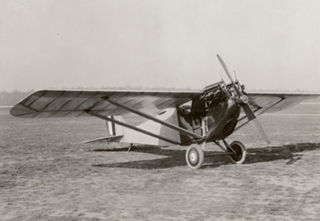
The Grumman F2F was a single-engine, biplane fighter aircraft with retractable undercarriage, serving as the standard fighter for the United States Navy between 1936 and 1940. It was designed for both carrier- and land-based operations.

The Naval Aircraft Factory SBN was a United States three-seat mid-wing monoplane scout bomber/torpedo aircraft designed by the Brewster Aeronautical Corporation and built under license by the Naval Aircraft Factory in Philadelphia, Pennsylvania. The landing gear was similar to that on the Brewster F2A Buffalo fighter aircraft. The SBN had non-folding wings with perforated flaps.

The Focke-Wulf Fw 57 was a prototype German heavy fighter and fighter-bomber. Prototypes were built in 1936 but never entered production.

The Naval Aircraft Factory TS-1 was an early biplane fighter aircraft of the United States Navy, serving from 1922 to 1929.

The Nieuport-Delage NiD 52 was a French fighter aircraft of the 1920s. A single-engined sesquiplane, it served with the Spanish Air Force, being operated by both sides of the Spanish Civil War.
The Arsenal VB 10 was a French fighter-interceptor aircraft developed during and shortly after World War II. It was a low-wing monoplane with retractable tailwheel undercarriage and of largely orthodox configuration. The ultimate product of a design that began with the Arsenal VG 10 prior to the war, the VB 10 added a second engine behind the cockpit which drove a second propeller, coaxial with and contra-rotating to the propeller driven by the engine in the nose.

The Nieuport-Delage NiD.62 was a French sesquiplane fighter from the early 1930s. This machine was a descendant of a long line of Nieuport-Delage fighters that were designed and built during the years immediately after World War I. The NiD.62 was built in 1931 as a fighter for the Armée de l'Air. It served until the late 1930s, when it was replaced by more modern monoplane fighters. By the time of the outbreak of World War II in September 1939, all of the NiD.62s had been withdrawn from front-line fighter escadrilles but were used as trainers in French flight schools. A few aircraft were employed as target tugs. After the French German Armistice and German occupation of North and West part of France in June 1940, the German Luftwaffe had no interest in the NiD.62s and they were scrapped. None survived the war.

The Loening M-8 was a 1910s American fighter monoplane designed by Grover Loening and built by his Loening Aeronautical Engineering Company. An order of 5000 for the United States Army Air Corps was canceled when the First World War ended.
The Renard Epervier was a Belgian prototype single-seat all-metal fighter monoplane designed by Alfred Renard at the Societé Anonyme Avions et Moteurs Renard for a government-sponsored design contest in 1928. The Epervier Type 2 was built and flown in 1928, by Belgian aircraft manufacturer Stampe et Vertongen. It carried an armament of two synchronised 7.7mm guns and was lost in September 1928 after failing to recover from a flat spin. A second prototype, the Epervier Type 2bis, introduced revised streamlined fairings for the cantilever mainwheel legs, mainwheel spats and cylinder aft-fairings and was built by SABCA.

The Eberhart XFG was an American single-seat experimental ship-borne biplane fighter aircraft developed for the United States Navy in 1927 by the Eberhart Aeroplane and Motor Company. The sole prototype was rebuilt into the XF2G with the addition of a single float and a different engine, but the aircraft was destroyed in a crash in 1928, and the type did not enter production.
The Chu XP-0, also known as the Chu (AFAMF) XP-0, was a Chinese fighter prototype in the Second World War.
The Beardmore W.B.II was a British biplane fighter prototype of the 1910s.

The Fokker D.IX was a Dutch single seat, single engine fighter aircraft, the final, more powerful evolution of the Fokker D.VII World War I success, flown in 1921. The sole example was purchased by the US Army Air Service but not developed further.

The Vickers F.B.16 was a British single-seat fighter aircraft of the First World War. It was originally designed to be powered by an experimental radial engine, development of which was abandoned. When re-engined with more powerful and reliable water-cooled V-8 engines, the F.B.16 demonstrated good performance, but only a few prototypes were built, the type not entering service.

The SNCAO 200, sometimes written CAO.200, was a prototype French single seat fighter aircraft of the 1930s. It was a single engined monoplane intended to compete with the Dewoitine D.520, but was unsuccessful, only a single example being built.

The Nieuport-Delage NiD 120 series was a series of French single-seat parasol monoplane fighter aircraft of the 1930s. It was built in a number of versions, fitted with various types of engines, with six aircraft designated NiD 123 being sold to Peru.

Naval Aircraft Factory NO was an American short-range reconnaissance/gun spotting aircraft of the 1920s. A single-engined three-seat biplane with alternative floats or wheels, six were built for the U.S. Navy.
The Mitsubishi Ka-8 or Mitsubishi Experimental 8-Shi Two-seat Fighter was a prototype Japanese two-seat carrier-based fighter aircraft of the 1930s. Two were built, but no production followed.

The SNCAC NC-600 was a prototype French twin-engined long-range fighter aircraft, developed by SNCAC from the earlier Hanriot H.220 fighter. The type never entered service, with development being ended by the French surrender in June 1940.
The Potez 230 was a French lightweight single-seat, single-engined fighter aircraft. One prototype was built and flew in 1940, but no production followed, with the prototype being captured and shipped to Germany for study.














